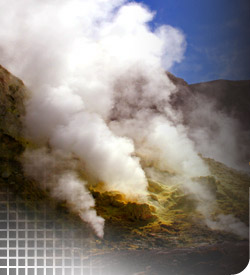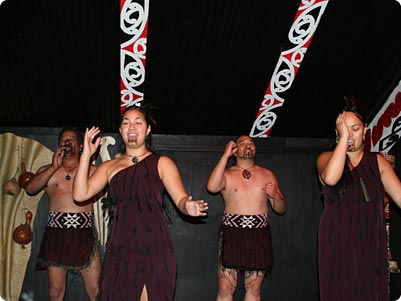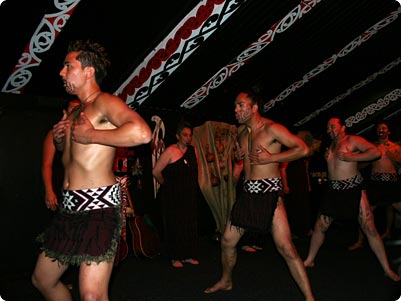 |
 |
|||||
 |
||||||
 |
WHY WE CHANT: Once a Kahuna who had been a student of Daddy Bray's, asked, "Why do you chant those old chants, why don't you let them die?" "Because they won't die," we replied. Even today they still call to us to be chanted. We know that Daddy Bray himself didn't feel that way about chanting. He chanted nearly every time he taught Huna, and he did think it was important. So why do we chant? We chant because chanting opens up the heart, and makes it swell and expand. We chant because at the deepest level of the meaning of the chant there is a vibration that corresponds to the meaning, and chanting opens up the neurology to that vibration. Once, someone asked Swami Muktananda (an Indian swami, and master teacher of meditation) why he chanted and taught chanting, and he said, "We chant because without the chant, the heart of a yogi becomes as dry as a leaf in the fall, and as brittle, too." The theory of chanting in both the Hawaiian system and the Sanskrit system (in India) says that the sounds being chanted, the tonal patterns and the frequency of the vibration of the sounds, invoke in the neurology of the listener and also the chanter, the deepest spiritual essence of what is being spoken of in the chant. Remember listening to a song, and notice that each word has a certain vibration in addition to the tune. In a Hawaiian chant, the vibration of the word has the same frequency as what is being spoken of at the deepest level of the chant. The ancient languages including Hawaiian, Greek, Latin, Hebrew have this effect. English does not. If you are Catholic, what was the difference between the Mass in Latin and the Mass in English? Do you remember the difference? Even if you do not remember, statistics show that attendance of the Sunday Mass dropped significantly when the Latin was eliminated. English, on the other hand, is a modern language, and so does not carry the same vibrations at its deeper level of sound as do the ancient languages. We have 10 to 10 to the 11th possible neurological connections inside our body, according to Dr. Paul Goodwin, Neurophysicist, at Alaska Pacific University. We only use 10-15% of them, he says. But what do you think the rest of the neurology is for? To be developed, we believe. Chanting does that, making new neurological connections which allow the experience of subtler levels of creation and vibration. That's why the tradition of Huna includes chanting. For example, we include chanting because by hearing the chants, every single pattern of sounds connects a certain set of neurology inside. So, simply hearing the sounds of the chants establishes certain neurological connections that you may have had before but do not currently have. If you have them already, then it strengthens those neurological connections. Simply put, we chant to expand our neurology and attune it to spirit, and to expand our consciousness.
THE DEEPER MEANING: Now, what do we mean by "deeper meaning?" The English language has 22 consonants and 7 vowels. The Hawaiian Language has 7 consonants (plus the glottal stop which is counted as a consonant by some linguists) -- h, k(t), l, m, n, p, w, plus the 5 vowels -- a, e, i, o, u. When you look at the structure of the Hawaiian language, from what you have seen here, you begin to notice that there are very few consonants. In fact seven or eight consonants and all the
vowels makes the language extremely simple. But the other thing about the language being that simple is that it's necessary for each single word to have a number of different meanings. Each word will need to have more meanings than English, some up to seven or eight meanings. Each word in Hawaiian has to do 3 or more times the work to produce the same meanings in Hawaiian that it does in English. This may have made Hawaiian the first phonologically ambiguous language! Let's look at a part of one of the chants: E Iho ana o Luna This was originally translated as: This: was originally translated as It was taken to be a prediction of King Kamehameha's uniting of all the islands around the late 1800's, as predicted by the Kahuna Kapihe of Kona, in 1850. But if you look at it with a different Kaona (a key to the context for translation of the chant), and you notice that "E Hui ana na moku" if taken as being inside the self could also mean to "make one of all the islands inside the self," then you get a substantially different translation: "Bring down that which is above by means of the light. To ascend take from darkness into light that which is below by means of light." This will transform the spiritual energy as it flows from the source and integrates all the islands (inside you), giving peace. This will affect you profoundly, and change your life bringing illumination, and you will feel the delightful supreme fire." What a difference! It is not surprising, however, that when the missionaries arrived, the Kahuna, who were MUCH more spiritually evolved than the missionaries were, hid the truth (about the ancient teachings) in the simple legends the missionaries wrote down for posterity. We believe that every single Hawaiian legend that predates 1850, probably has hidden inside it, the ancient teachings. (Further research needs to be done on the Fornander Collection, for example.) Discovering this is one of our great passions, and we are still in the process of going back and rediscovering the ancient hidden teachings. The reason why we like Huna is because it was relatively untouched by Western hands until the first missionaries arrived in Hawaii in 1820, and when the original teachings were hidden, they were well hidden. So, much of the teaching of Huna is relatively well preserved. Unlike other disciplines in North America and the world, the Hawaiians were only subjected to persecution of the knowledge for a short period of time. When the missionary arrived in Hawaii, he looked at the Hawaiians who were dressed in fewer clothes, and decided that he (the missionary) was superior. They came from Boston, wearing tall hats, dark coats, long woolen trousers and long underwear because that is the way one dressed. They looked at the Hawaiians and said, "Look at how they dress. What could they know?" So, the newcomers outlawed the practice of Huna, and that, in a country that prides itself in the freedom of religion and freedom of speech. It may also be that the Kahuna did not just hide the truth; it may just be that the missionaries were not capable of understanding the truth. There are, however, numerous stories of the missionaries' inability to comprehend. Leinani Melville [Melville, 1969] says that the Kahuna refused to share any more information with the missionaries when the later refused to acknowledge that the ancestors of the Hawaiians could have come from Na Lani (the heavens). If they could not even get that right, how could they be trusted with more sacred things which were beyond their comprehension? It is fortunate that the ancient teachings of Hawaii were only suppressed for seven generations, instead of twenty or thirty generations as in the other parts of the world. So, one job that still needs to be done is to retranslate more of the ancient chants, to bring back the ancient meanings. If you could like to learn more about the process of chanting , click here. Click here to: See Pictures of the Huna Intensive. If you can't join us in person, you can find Huna training on tape. This is an excellent resource for review or preparation for any of our Huna trainings: Huna: Exploring the Ancient Wisdom
|
| Copyright © Tad James Co, 2005-11 | General Information | Lineage | What is Huna | Meditation | Chanting | Symbols |


